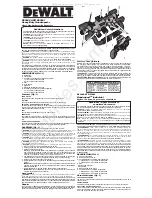
Page 44 Non-Sound Decoder MX618 - MX634 and Sound Decoder MX640 - MX648
CV
Designation
Range
INC-
step
De-
fault
Description
#158
Various special bits
-
0
Bit 0 = 1: SPECIAL MX648: Function output FO1
is used for an automatic control line of an external
energy storage.
Bit 1 = 1: DIESEL-MECHANICAL: No RPM
increase when braking (see CV #364).
Bit 2 = 0: RailCom actual speed (kph) feedback in
“old” format (for MX31ZL, RailCom ID 4).
= 1: RailCom actual speed (kph) feedback in
current format (RailCom ID 7).
Bit 3 = 1: “Looped” driving sounds will be faded
out when switching to a different speed
step in order to shorten the sounds.
Bit 4 = 1: Steam chuff frequency increases slower
at high speed (non-proportional)
Bit 5 = 1: Braking (even by one speed
step) causes the motor and turbo
sounds to decrease by on sound step.
Bit 6 = 1: Thyristor sound may be louder when
braking (even if the volume is supposed
to decrease according to CV #357); see
CV #357.
Bit 7 = 1: SPECIAL MX645: ELECTRIC: Flashes
of light (approx. 0.1 sec) on FO7 when
switch gear sound is played.
#394
Sample crossfading
0 - 255
-
0
Bit 0 = 1: SPECIAL MX645: ELECTRIC: Flashes
of light (approx. 0.1 sec) on FO6 when
switch gear sound is played.
Bit 4 = 1: Faster acceleration when speed
regulator fully opened.
Bit 5 = 1: Crossfading of chuff samples
5.6 Steam engine
Load and acceleration dependency
The
load dependency
of the sound is
based on the current engine
load
and
the
acceleration / decel-
eration.
The result of the “basic” load test run serves as reference for the current motor load, see sec-
tion 5.3 "
The test run for determining the motor’s basic load”.
NOTE: ZIMO large-scale decoders MX695 and up, and possibly some of the smaller decoders (but
not the current MX640
– MX648’s) contain a position and acceleration sensor that will improve the
function of load dependency dramatically, once it is activated with future software versions.
To set up load dependent sound, follow the
instructions in this order:
+
Perform
"
The test run for determining the motor’s basic load”
; see chapter 5.3
+
Adjust CV’s #275 and #276
+
Adjust CV #277
+
If needed CV #278 and #279
NOTE: The CV’s in this chapter affect the sound volume according to load (that is, by how much the
volume should increase at higher loads or decrease at lesser loads, all the way down to mute if nec-
essary). A possible exchange of sound samples at load increase or decrease is however a matter of
the sound project. There are however special exceptions to this rule...
CV
Designation
Range
INC-
Step
Default
Description
LEAD
- CV
#275
Chuff sound
volume at low speed
and no-load
0 - 255
10
60
With this CV the chuff volume can be adjusted
for low speed and
“basic load” (same conditions
as during the
“automated recording run”).
Here, the engine is driven by about 1/10 of its
full speed, adhering to the exact speed is how-
ever not important.
During this adjustment CV #277 is to be left at
“0” (default), so that the setting for “no-load driv-
ing” is not influenced by load factors.
#276
Volume at high
speed and no-load
0 - 255
10
80
Same procedure as in CV #275 above, but for
high speed.
CV #276 defines the “basic-load” chuff sound
volume at full speed. Set the speed regulator to
maximum during this set-up.
#277
Chuff volume
changes according
to load
0 - 255
10
0
=
no
reaction
When deviating from the basic load (as deter-
mined by the “Automated recording of the mo-
tor’s “basic load” factor”, see above), the chuff
beat volume should be increasing (on inclines)
or decreasing on declines (even muted).
CV #277 defines the degree of change, which
must be set to the proper value by trial.
LEAD
- CV
Load change
threshold
0 - 255
10
0
With this CV, a change in volume to small load
changes can be suppressed (i.e. in curves) in
NOTE: The
default values
listed for the individual CV’s are typical guidelines only,
as actual
values in operation are determined by the loaded
sound project;
this also means that a HARD
RESET with CV #8 = 8 restores the values back to the definition in the sound project.
















































